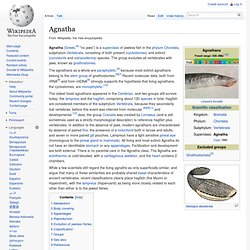

Agnatha. The agnathans as a whole are paraphyletic,[5] because most extinct agnathans belong to the stem group of gnathostomes.[6][7] Recent molecular data, both from rRNA[8] and from mtDNA[9] strongly supports the hypothesis that living agnathans, the cyclostomes, are monophyletic.[10] The oldest fossil agnathans appeared in the Cambrian, and two groups still survive today: the lampreys and the hagfish, comprising about 120 species in total.

Hagfish are considered members of the subphylum Vertebrata, because they secondarily lost vertebrae; before this event was inferred from molecular [8][9][11] and developmental [12] data, the group Craniata was created by Linnaeus (and is still sometimes used as a strictly morphological descriptor) to reference hagfish plus vertebrates. In addition to the absence of jaws, modern agnathans are characterised by absence of paired fins; the presence of a notochord both in larvae and adults; and seven or more paired gill pouches. Vertebrate. Vertebrates /ˈvɜrtɨbrəts/ are animals that are members of the subphylum Vertebrata /-ɑː/ (chordates with backbones).

Vertebrates include the overwhelming majority of the phylum Chordata, with currently about 64,000 species described.[2] Vertebrates include the jawless fish and the jawed vertebrates, which includes the cartilaginous fish (sharks and rays) and the bony fish. A bony fish clade known as the lobe-finned fishes includes the tetrapods, which are divided into amphibians, reptiles, mammals, and birds.
Node.